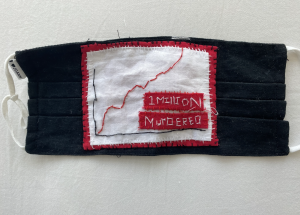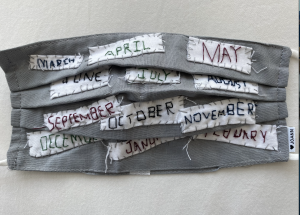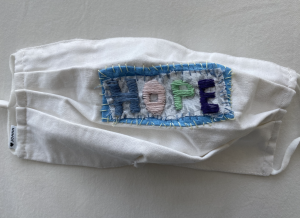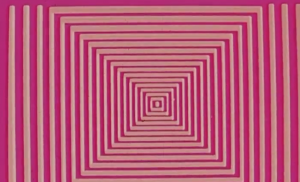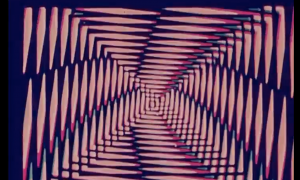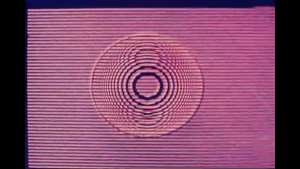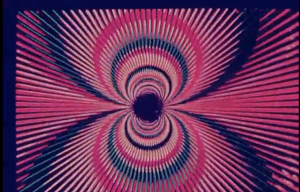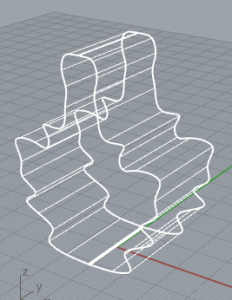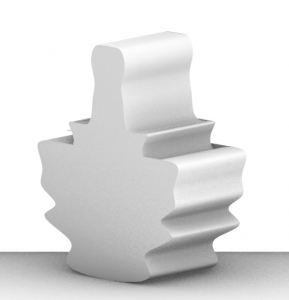2 Claire Billman on Stan VanDerBeek
Claire Billman is a Global Public Health and Interdisciplinary Honors student with plans to become a Physician Assistant. Outside of the classroom, she is passionate about researching SynGAP-1, a rare mosaic mutation that impacts neurological development, and connecting families impacted by it. Her favorite medium to use is film and she has a personal goal to become a great home chef.
Stan VanDerBeek (January 6, 1927- September 19, 1984) was an American painter turned filmmaker who studied at Copper Union and Black Mountain College. He had a long and diverse art career that was focused on experimentation and incorporated many mediums.
Hello Mr. VanDerBeek,
The world today is extremely different from the world that you knew!
Technology, such as personal computers and 3D printers, are no longer reserved for top government agencies and technical Universities. Lasers can fit into your pocket and entire films can be created solely on cellular phones. Additionally, we are currently living through a global pandemic. For the past year, our lives have centered around technology and the internet.
In fact for a recent project that I completed titled, “Cycles” I drew inspiration from the pandemic and used embroidered masks to express the emotions that I have felt waiting for it to be over. Below are photos of the masks that I used. The black one represents anger, the white one hope, and the gray is a combination of the two.
- “Anger” mask, Claire Billman, Photography
- “Waiting” mask, Claire Billman, Photography
- “Hope” mask, Claire Billman, Photography
I found that I was not able to completely and fully express my message with just textiles alone and as a result incorporated a film aspect. I felt that filming the movement and application of my masks would resonate better with the audience and combine multiple mediums. Additionally, due to the pandemic today more than ever before, cameras and videography allow us to share stories, communicate, and fill the time. I believe you once went as far as to say that film is “the most total media”[1] and I agree.
The Reinvention of Happenings
I did not have a plan while creating and was freestyling in how I wanted to express my emotions. In fact, I just started recording and experimented with different movements and angles. In my video which can be found here, you can see the final version of my experimentation.
After some reflection, I now realize how this filmed performance is more similar to a happening than a scripted story. Every move I made inspired the creation of my next moves. I think I did not initially consider my film as a happening because the experience of watching a video is so different than an in-person performance. Specifically, what we see in a film is a decision that the creator made. We see what they want us to see. During an in-person performance, like a happening, you see it all and can choose where you want to look. The viewer makes a choice.
When considering if my film counted as a happening, I drew upon your time at Black Mountain College for guidance. Specifically when you started filming happenings. To me, those videos and my own film are a kind of digital happening. Additionally, I noticed that many of your other films capture similar themes traditional to happenings.
Your films are full of seemingly random and organic creations. As I previously mentioned, films are very limited in that the creator determines what the audience is supposed to see. However, with your use of visual effects, you are able to create the feeling that the viewer could choose what they would pay attention to. I first noticed this in your short film “Moirage”. Specifically, your constant manipulation of the visual felt like I was looking through a digital kaleidoscope. Even while I was rewatching it for the 2nd time I noticed elements that I hadn’t previously seen. This felt similar to the chaotic and overwhelming happenings that took place at Black Mountain College as there were too many things going on for the viewer to be able to absorb it all. For example, I failed to notice that you essentially go through the same progression of effects two “scenes” in a row.
Initial scene
- Screenshot from “Moirage”, Stan VanDerBeek, Film
- Screenshot from “Moirage”, Stan VanDerBeek, Film
Subsequent scene
- Screenshot from “Moirage”, Stan VanDerBeek, Film
- Screenshot from “Moirage”, Stan VanDerBeek, Film
I think that the techniques and the almost “trippy” feeling of the special effects made the feeling of choice possible. I will definitely have to experiment on my own to understand this better!
Digital Crafting
The Italian Futurist went as far as to say that “performance art was the only way to reach a mass audience”[2].
Given this statement was made prior to the rise of the internet I think it is worth considering the role that performance art plays today. I would argue that today performance art is dependent on film if it wants to reach a large audience. Even more, it was the combination of film, the internet, and performance art that changed the definition of a “mass audience”.
A prime example of this is the Social Media app TikTok. Essentially TikTok is a platform anyone can sign up for and post videos to. An algorithm will then decide which videos a certain user will enjoy. Applications like TikTok and other social media platforms gave rise to the idea of viral videos. Essentially the creation of viral content is centered around making something that will be shocking, heartfelt, or unique enough that everyone will want to see it. Since viral videos can get MILLIONS of views, shape pop culture, and give their creator fame, many people desire to create such content. You were right in saying that computers serve as a tool to amplify the thoughts of the creator! It is interesting to consider how digital crafting today has strayed from the traditional definition of crafting. More specifically the inspiration of crafting using social media platforms has “emphasized output, not input” [3].
When you compare the creation of TikTok content to some of your work it is interesting to consider how the audience plays a role. By that I mean if you are going to make different content a piece is reaching 1 million people vs. 15. Over the past quarter, I have been able to experiment with this. For my film “cycles” I was creating a video for 20 people who have a background understanding of happenings and art. Knowing that my audience would notice the small choices I made inspired and challenged me. I paid more attention to my movements and the unspoken message I was conveying. I felt that I could be more authentic and had more overall creative freedom.
In addition to creating my film “Cycles”, I was also assigned to make a TikTok PSA for a different class. The creation of my TikTok felt very different. The main goal I had for this video was to create content that everyone would understand. I knew that if I wanted my video to be picked up by the algorithm that I would have to follow a certain style of video. Because of this, I used a popular sound, hashtags, and even changed the pitch of my voice so it came across as more feminine and welcoming. I made these choices not because I was inspired to do so, but felt it was necessary for the platform.
Innovation of Self
While our access to technology has changed radically from when you were experimenting with it, the technical skills to use it continue to be a barrier. Just as you commented on and exercised, collaboration continues to be the main way to reduce this barrier and is necessary when using new technologies.
However, I found that my understanding and use of collaboration were different from your experience. Specifically, when you spoke of collaboration I believe you meant more of a mode of creation of new technology. During this you would collaborate with numerous engineers and would eventually end up with your own artwork and the engineer would have a new program. This process would be rooted in creativity and like a happening, structured in the understanding that every move you make inspires the next.
Unlike when you spent time at NASA and MIT we no longer need to consult a scientist to learn a new program. In fact for a project that I recently did, I was able to learn a completely new computer program from videos that everyday people uploaded to the internet. The rise of the internet and sharing platforms has allowed for more collaboration than ever before. Yet, most of the collaboration occurring is not human to human, but rather human knowledge uploaded to servers that are then accessed by other computers. Thus the element of personalization and the organic creative process between artists has declined.
My recent project used a program called Rhino, which essentially makes 3D objects that can eventually be 3D printed. I have added a photo of my creation known as “The Real MacCoy” to give you a better idea of what I’m talking about.
- Wire Render, Claire Billman, Rhino 7
- 3D Render, Claire Billman, Rhino 7
I had never used this program before but had a very specific vision for what I wanted to create. I now realize that I had such a specific vision for my project since I knew how limited my technical skills were. I felt equipped to be creative while brainstorming since it didn’t require any additional knowledge unlike when I used Rhino.
To gain the necessary knowledge to use Rhino I watched videos on a website known as Youtube. I felt like I was able to gain access to a new tool and knowledge, but its transactional nature did not feel like an authentic collaboration. In a way, it felt like an exchange of goods where the commodity was knowledge.
Upon further reflection, I have realized that much of my school experience has felt like this. For some context, I am currently studying to become a Physician Assistant. Due to my major, most of the knowledge I am learning is from other people’s experiments and not my own. Additionally, the classroom is centered around my professors and we are tested on how well we are able to absorb their knowledge of a subject. This is very different from your time at Black Mountain College! As you know the living and learning community was very equalizing and centered around personal experimentation. The teachers learned from their students which highlights the notion that everyone had something to offer.
Man-Machine Relationship
You were right in that the relationship between Man and Machine was going to change the way we communicate with one another. Due to the pandemic, any unnecessary human interactions have moved online, and the only way I see human faces without masks on is through video calls.
Pandemic aside, the rise of this relationship has changed the quality of human relationships. I agree with you that computers serve as a tool to amplify the thoughts of the creator. However, I don’t think you could have foreseen the extent to how this tool would also amplify human biases and polarize the world. In your manifesto, you began to consider the general idea of how a man would lose his way as his relationship with machines intertwined[4] but I’m afraid it’s worse than you could have foreseen.
TikTok is just one of many internet-based applications, known as social media platforms, that use algorithms to personalize the experience the user has. In a way, this is kind of like your idea of the audience having control over the viewing experience of a film. However, the algorithm used on these platforms takes away the element of human choice by playing into the human reward pathways. As a result, people are only seeing what the computer thinks they want to see. This is both highly addictive and creates echo chambers of thought that are highly manipulated and polarizing.
This idea of a limited or obscured view is not unique to social media platforms. We have already discussed how film inherently limits what the audience can see, and can be manipulated into creating a false narrative. With the rise of viral videos comes the rise in the consumption of manipulated content. It is the combination of the rise of manipulated content along with algorithm-based echo chambers that have contributed to the extreme polarization around the world.
On January 6th, 2020 a line in your manifesto came true when a domestic terrorist group attacked the United States Capital. You said, “man is running the machines of his own invention… while the machine that is man… runs the risk of running wild” [5]. The algorithm that gave rise to the polarization in the U.S. was a man-made creation which, in turn, made men attack one another. Since then conversations surrounding our relationship with technology have shifted into how we can begin to control it.
As you can see the world today is very different from when you left it. Nevertheless, there is still plenty of exploration, creation, and reflection to be done! I hope you enjoyed hearing about the relevance and purpose your work still serves today!
Talk to you soon.
Claire Billman
References
- Stan Vanderbeek: The Computer Generation Part 1. YouTube. YouTube, 1972. https://www.youtube.com/watch?v=mg_DowyLuT8. ↵
- The Art Assignment. PBS. Public Broadcasting Service, 2016. https://www.pbs.org/video/the-case-for-performance-art-p8suli/. ↵
- McCullough, Malcolm. 1996. Abstracting Craft : the Practiced Digital Hand. Cambridge, Mass.: MIT Press. abstracting_craft_mccullough-1.pdf ↵
- UbuWeb Film & Video: Stan VanDerBeek. Estate of Stan VanDerBeek, 2008. https://www.ubu.com/film/vanderbeek.html. ↵
- UbuWeb Film & Video: Stan VanDerBeek. Estate of Stan VanDerBeek, 2008. https://www.ubu.com/film/vanderbeek.html. ↵

